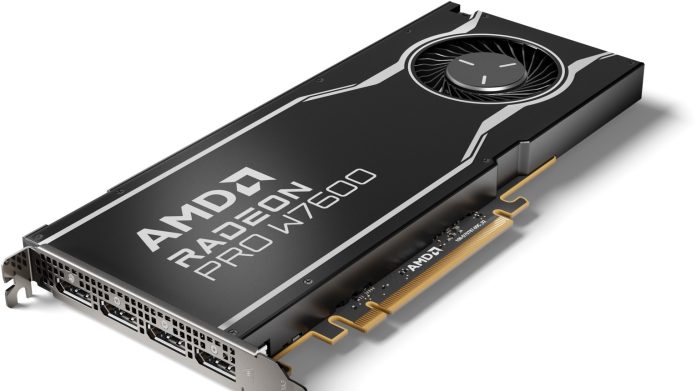AMD’s ready to roll out the newest graphics cards in its Radeon Pro product line, this time targeting entry-level-to-midrange and small form-factor desktop workstations. The new Radeon Pro W7600 and Radeon Pro W7500 are designed to produce speedy performance inside a compact single-slot package. These cards are also relatively budget-friendly, retailing for $429 and $599 respectively, making them highly competitive in price with Nvidia’s base-level RTX A Series GPUs for workstations.
AMD’s Navi 33 Goes Pro
At the heart of both the Radeon Pro W7600 and Radeon Pro W7500 lies an AMD Navi 33 GPU core, which is the same core used inside the AMD Radeon RX 7600 graphics card. This core contains 2,048 streaming processors, 32 Ray Accelerators, and 64 AI Accelerators. The Radeon Pro W7600 has access to the full core and all of these resources, but the W7500 has a partially disabled core that leaves it with just 1,792 streaming processors, 28 Ray Accelerators, and 56 AI Accelerators.
(Credit: AMD)
All of these GPUs connect to 8GB of GDDR6 memory over a 128-bit memory interface, but the Radeon Pro W7500 is handicapped here too, as it uses slower memory.
Though the Radeon Pro W7600 should be clearly the faster of these two new cards, both GPUs have clear merits that make them both equally appealing. The Radeon Pro W7500 makes up for its smaller core count with a lower 70-watt power draw, which means it does not require supplemental power from a PCIe cable. This makes it an alluring option for space- or- power-constrained systems.
(Credit: AMD)
You will need additional power for a Radeon Pro W7600, as it’s rated to consume 130W, but if your system can support this, it’s likely well worth the trade-off. The higher core count and greater memory bandwidth should result in a significant performance boost. In spite of the higher power draw, this card also uses a single-slot design, making it easy to fit multiple cards into a single system for additional performance. This is also reflected in the prices of the two cards, with the Radeon Pro W7500 again costing just $429 and the faster W7600 asking for $599.
What Did AMD Improve, Exactly?
Compared with AMD’s last-generation Radeon Pro W6600, these cards have some notable advantages. The W7500 is on average slower than the older W6600, but it again makes up for this with its significantly lower price and power draw. In the right scenario, however, the W7500 may also be able to perform better than or on a similar level to the W6600. The faster W7600 tends to outpace the W6600 and usually by a significant margin, as shown in AMD’s chart above.
Recommended by Our Editors
(Credit: AMD)
Both the Radeon Pro W7500 and Radeon 7600 also benefit from upgraded connection standards, including DisplayPort 2.1 support, which provides significantly more bandwidth over the older DisplayPort 1.4 standard found on the W6600. This helps to support elevated resolutions and color depth for professional monitors that are used for content creation. AI performance and ray-tracing performance are both claimed to have gone up significantly from the previous generation, with up to a 230% and 50% increase, respectively.
(Credit: AMD)
AMD plans to launch both cards sometime during Q3 at the aforementioned prices. With cards in hand, we’ll have reviews of both the Radeon Pro W7500 and W7600 published in the near future.
Get Our Best Stories!
Sign up for What’s New Now to get our top stories delivered to your inbox every morning.
This newsletter may contain advertising, deals, or affiliate links. Subscribing to a newsletter indicates your consent to our Terms of Use and Privacy Policy. You may unsubscribe from the newsletters at any time.
Visits: 0



















